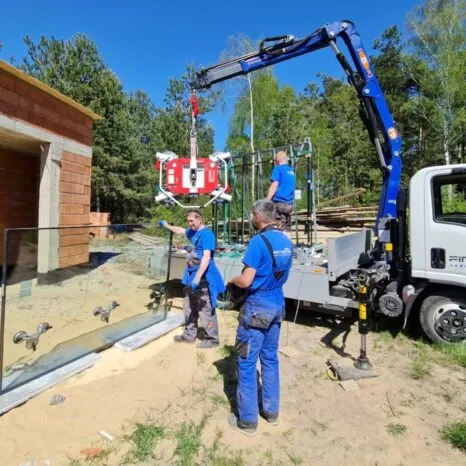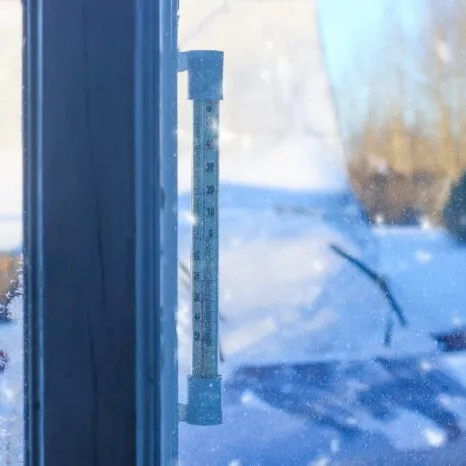Seasonal inspection of windows and doors, i.e. how to prepare window joinery for winter?

The autumn and winter period is a time when our houses or flats are put to the test in terms of thermal insulation and weather resistance. One of the most important elements that have an impact on thermal comfort and energy savings are undoubtedly windows and doors. After all, neglected window and door frames can lead to large heat losses, which in turn result in higher heating bills.
That’s why it’s a good idea to carry out a thorough inspection and maintenance of your windows and doors before the winter season to ensure that they are properly sealed and durable. With this in mind, here’s a comprehensive guide on how to prepare your joinery for winter to enjoy thermal comfort all year round, whatever the weather outside.

Why inspect windows and doors before winter?
In winter, when the temperature outside drops, our heating systems work at full capacity to keep us warm. Unfortunately, if windows and doors are not properly sealed, warm air will escape to the outside and cold air will get in. This consequently results in huge heat losses through leaks, which can be as high as 25-30%, significantly increasing heating costs.
In addition, leaks can lead to problems with dampness and draughts, which negatively affects the comfort of the home and can encourage the growth of mould and mildew, which not only lead to the need for renovation, but above all negatively affect the health of householders. Therefore, regular inspection of window and door joinery is a key step in preparing for winter, which will not only ensure savings but also improve quality of life.
First step – checking the technical condition of windows and doors
Before you start maintaining and sealing your windows and doors, it is a good idea to first carefully check their condition. Here are some key areas to pay particular attention to:
- Seals – check that the seals on your windows and doors are in good condition. Over time, they can wear, crack or warp, leading to a loss of airtightness. So if you notice that the seals are cracked or deformed, it is worth replacing them immediately.
- Locks and hinges – test the operation of locks and hinges. If a window or door joinery has a hard time opening, jams or creaks, this could be a sign that it needs adjusting or lubricating.
- Glazing – make sure the glass in your windows is tightly seated. When doing so, pay attention to any cracks or nicks that may lead to heat loss.
- Frames – window and door frames can deform over time, which also affects their airtightness. Therefore, check that they are not damaged or warped.

Step two – thoroughly wash the window and door frames
To properly prepare windows and doors for winter, the second step should be to wash them thoroughly. It is important to choose a day with suitable weather conditions – preferably warm, but not too sunny. This is because high temperatures and intense sunshine can cause water to dry quickly, often leading to streaks. Conversely, at low temperatures, glass becomes more brittle and can crack.
When cleaning your windows, it is a good idea to use dedicated cleaning products and a soft cloth. If you prefer natural methods, a mixture of vinegar and water will perfectly remove greasy stains and make the glass shine. Remember also to clean additional window elements, such as ventilators. It is best to dismantle them and rinse them thoroughly with water to ensure their smooth operation during the winter season. In the case of exterior doors, use a damp cloth. A detergent may only be useful for cleaning gaskets or the area around the hinges, which certainly cannot be cleaned with water alone.
Such preparation of windows and doors for winter is crucial and extremely important for maintaining their functionality. After all, clean joinery means less room for the growth of micro-organisms, which can weaken the surface of window profiles by creating invisible pores through which dirt can penetrate.
Maintenance and sealing of windows and doors
Once the technical inspection has been carried out, it is a good idea to proceed with the maintenance of the window and door frames as the next step. Here are some steps to help protect your windows and doors against winter:
- Replacing the gaskets – if you have noticed that the gaskets are worn, they should of course be replaced with new ones. There are different types of gaskets available on the market, which can be easily adapted to the type of windows and doors. Replacing them is a quick and easy way to improve thermal insulation.
- Adjusting the fittings – the fittings on windows and doors can become loose over time, leading to them not seating properly. Before winter, it is therefore a good idea to carefully adjust the fittings so that the windows and doors are tightly closed. This will largely minimise heat loss and ensure greater structural stability.
- Lubricating hinges and locks – to avoid problems with opening and closing windows and doors in cold weather, it is a good idea to lubricate the hinges and locks with special preparations. This is particularly important if you have previously cleaned the joinery, following the above paragraph. This will ensure that the mechanisms operate smoothly and reduce the risk of jamming.
- Protecting the frames – if you notice damage on your window or door frames, such as paint chips or cracks, it is worth repairing them. In the case of wooden frames, it is also worth protecting them with special preparations that protect the wood against moisture and frost.

Switching windows to winter mode – how do you do it?
Another aspect we absolutely have to mention, which not everyone knows about, is the so-called winter mode of the windows! This is based on changing the position of the window sash in relation to the frame. By adjusting the mechanism by 90 degrees, we increase the tightness of the windows, which of course helps to reduce the flow of cold air from outside into the rooms. This is particularly important during the winter season, especially when you realise how many windows you have in your house or flat….
But how do you convert your windows to winter mode correctly? Fortunately, converting windows to winter mode is a very simple and quick process that we can do ourselves without the need for a professional. How to do it? You will need a screwdriver, allen spanner or sometimes pliers – depending on the window model. When you open the window, you will find a screw (pin) on the sash that is placed in the guide. The current setting is summer mode – to change to winter mode, simply rotate the pin 90 degrees from its previous position. If the pin does not have a flat entry, we can use pliers. As a result, the seal is pressed tighter in winter mode, improving insulation and reducing airflow through the window.
Additional solutions for improved insulation
In addition to the standard maintenance measures, there are several additional solutions that can significantly improve the thermal insulation of window and door frames, especially if they are already years old.
- Thermal insulation films – installing thermal insulation films on window panes is a simple and effective solution to reduce heat loss. These films reflect heat back into the room, making heating more efficient.
- External and internal roller shutters – External and internal roller shutters can act as an additional insulation layer. This is because closed roller shutters help to keep the heat in and at the same time protect the windows from wind and snow.
- Sealing the door – the seals around the door, especially those at the base, can lose their effectiveness over time. Replacement or additional sealing can in turn prevent draughts and heat loss.
- Thermal insulation mats – for particularly older doors that may have poorer insulation, consider purchasing thermal insulation mats. Such mats can be fitted to the inside of the door to help improve its insulation performance.
How do you prepare your doors for winter?
As with windows, external doors also need to be properly prepared for winter. It is therefore worth paying attention to several key aspects, the first of which include:
When should windows or doors be replaced?
Despite regular maintenance and careful care, window and door joinery can cease to serve its purpose over time. If you notice that rooms are becoming difficult to heat and your heating bills are rising, this could be a sign that your windows or doors no longer provide sufficient thermal insulation. This is because older models, even after repairs, are often no match for modern products that have much better energy performance and airtightness.
In this case, it may be necessary to replace the windows and doors with new ones, which not only improve thermal comfort, but also acoustic comfort – newer solutions effectively dampen noise from outside, which is particularly appreciated by city dwellers. In addition, modern windows and doors are more resistant to damage and wear, which translates into their longer life and reduced need for servicing. As a result, the investment can contribute to significant savings on heating, while increasing the value of the property and improving the day-to-day comfort of the flat, home or business.

















